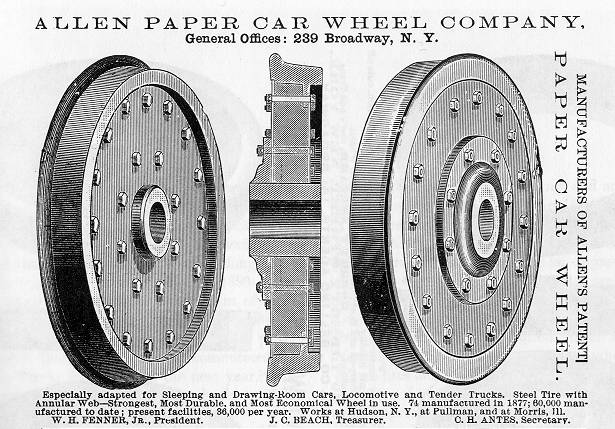Paper Wheels
Cast iron wheels had always been the standard for railroad wheels, but were subject to failure due to imperfections in the casting process as well as extremes of temperature such as being heated by dragging brake shoes during chill winter months. (White/Passenger-532ff has an extensive discussion of this.) A number of experiments were performed using a combination of cast iron hub and wrought iron tire with wood between. These wood-centered wheels had been introduced in England as early as 1848, and by 1860 were being tried in this country. The inventor of the “paper” wheel was a former locomotive engineer, Richard N. Allen (1827-1890). Allen had tried a number of occupations before being persuaded by his brother to become part-owner of a paper mill at Pittsford, Vermont. The mill’s primary product was a cheap grade of strawboard of which there was already a plentiful supply, so Allen soon found himself with little business. He set out to find other uses for his strawboard, and from his railroad experience decided to try substituting the strawboard for the wood in fabricated wheels.
One disk held the tire, while the other held the hub. The paper separating the disks, though greatly compressed and nearly as hard as ivory, was just spongy enough to cushion the ride and deaden the sound of the wheels grinding over the rails. Allen began business in 1868 as the American Paper Car Wheel Company. In 1869 he got a U.S. patent on his design. But the idea of a “paper” railroad car wheel was more a joke than anything else. Until, that is, the day in 1870 that George Pullman purchased a set of Allen’s wheels. They worked well, and Pullman bought more. Ever the publicity hound, Pullman probably adopted the wheel as much for the publicity as for its merit. But his patronage converted the paper wheel from an oddity to a staple of luxury railroad travel. Allen established a plant in Hudson, NY in 1873, and advertisements exist for the Hudson Paper Car Wheel Co., though what relationship that had to Allen is unknown to this author. By 1881 Pullman was using so many of Allen’s wheels that Allen’s main plant was located on the grounds of Pullman’s Chicago works. More and more of the Allen patent wheels were produced, to the point that in 1886 the firm announced it had 60,000 wheels in service. Seven years later it had 115,000. This, of course, drew many imitators, using many different, and sometimes downright weird schemes. In 1897 the nine most important manufacturers of fabricated wheels combined to form the Steel Tired Wheel Company. The company prospered for a decade, then went into decline. The weight of steel cars was too great. Greater speed put more stress on the wheels. And the advent of new steel technology made fabricated wheels obsolete.
|
|||||||||||||||||||||||||

 In
Allen’s earliest process, circular sheets of paper were glued together with flour paste
until sufficient thickness was obtained, then compressed by a 650 ton press for
three hours. They were then allowed to dry for six to eight weeks under
controlled temperature to evaporate all moisture. This paper disk, now
resembling a wooden wheel, was then turned to size on a lathe. Holes were
drilled through it, and it was bolted between two ¼" iron plates with 24 bolts
or more. The outer ring of bolts held the outer iron disk in contact with the
tire, while the inner ring of bolts held the inner iron disk in contact with the
hub.
In
Allen’s earliest process, circular sheets of paper were glued together with flour paste
until sufficient thickness was obtained, then compressed by a 650 ton press for
three hours. They were then allowed to dry for six to eight weeks under
controlled temperature to evaporate all moisture. This paper disk, now
resembling a wooden wheel, was then turned to size on a lathe. Holes were
drilled through it, and it was bolted between two ¼" iron plates with 24 bolts
or more. The outer ring of bolts held the outer iron disk in contact with the
tire, while the inner ring of bolts held the inner iron disk in contact with the
hub.